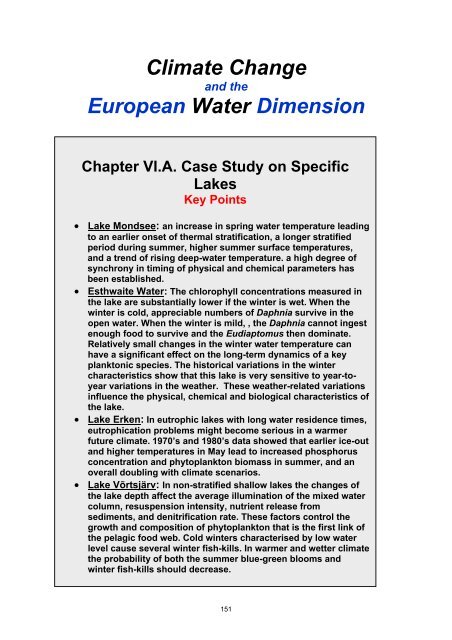Climate Change and the European Water Dimension
Climate Change and the European Water Dimension
Climate Change and the European Water Dimension
Create successful ePaper yourself
Turn your PDF publications into a flip-book with our unique Google optimized e-Paper software.
<strong>Climate</strong> <strong>Change</strong><br />
<strong>and</strong> <strong>the</strong><br />
<strong>European</strong> <strong>Water</strong> <strong>Dimension</strong><br />
Chapter VI.A. Case Study on Specific<br />
Lakes<br />
Key Points<br />
• Lake Mondsee: an increase in spring water temperature leading<br />
to an earlier onset of <strong>the</strong>rmal stratification, a longer stratified<br />
period during summer, higher summer surface temperatures,<br />
<strong>and</strong> a trend of rising deep-water temperature. a high degree of<br />
synchrony in timing of physical <strong>and</strong> chemical parameters has<br />
been established.<br />
• Esthwaite <strong>Water</strong>: The chlorophyll concentrations measured in<br />
<strong>the</strong> lake are substantially lower if <strong>the</strong> winter is wet. When <strong>the</strong><br />
winter is cold, appreciable numbers of Daphnia survive in <strong>the</strong><br />
open water. When <strong>the</strong> winter is mild, , <strong>the</strong> Daphnia cannot ingest<br />
enough food to survive <strong>and</strong> <strong>the</strong> Eudiaptomus <strong>the</strong>n dominate.<br />
Relatively small changes in <strong>the</strong> winter water temperature can<br />
have a significant effect on <strong>the</strong> long-term dynamics of a key<br />
planktonic species. The historical variations in <strong>the</strong> winter<br />
characteristics show that this lake is very sensitive to year-toyear<br />
variations in <strong>the</strong> wea<strong>the</strong>r. These wea<strong>the</strong>r-related variations<br />
influence <strong>the</strong> physical, chemical <strong>and</strong> biological characteristics of<br />
<strong>the</strong> lake.<br />
• Lake Erken: In eutrophic lakes with long water residence times,<br />
eutrophication problems might become serious in a warmer<br />
future climate. 1970’s <strong>and</strong> 1980’s data showed that earlier ice-out<br />
<strong>and</strong> higher temperatures in May lead to increased phosphorus<br />
concentration <strong>and</strong> phytoplankton biomass in summer, <strong>and</strong> an<br />
overall doubling with climate scenarios.<br />
• Lake Võrtsjärv: In non-stratified shallow lakes <strong>the</strong> changes of<br />
<strong>the</strong> lake depth affect <strong>the</strong> average illumination of <strong>the</strong> mixed water<br />
column, resuspension intensity, nutrient release from<br />
sediments, <strong>and</strong> denitrification rate. These factors control <strong>the</strong><br />
growth <strong>and</strong> composition of phytoplankton that is <strong>the</strong> first link of<br />
<strong>the</strong> pelagic food web. Cold winters characterised by low water<br />
level cause several winter fish-kills. In warmer <strong>and</strong> wetter climate<br />
<strong>the</strong> probability of both <strong>the</strong> summer blue-green blooms <strong>and</strong><br />
winter fish-kills should decrease.<br />
151

















